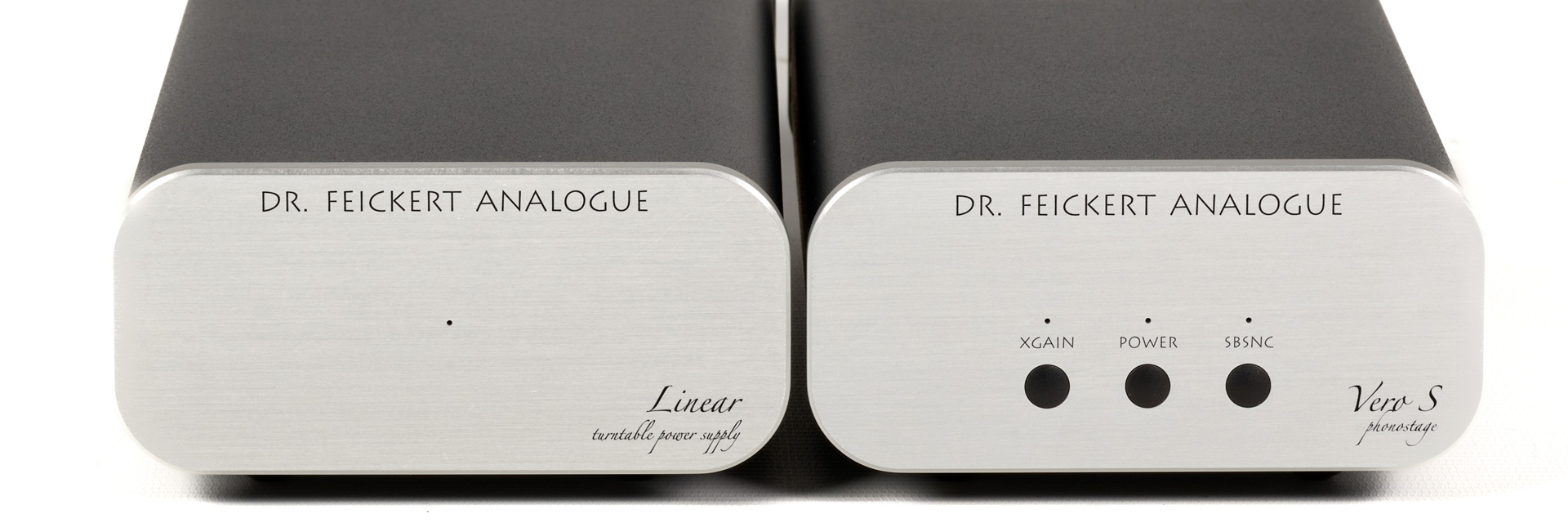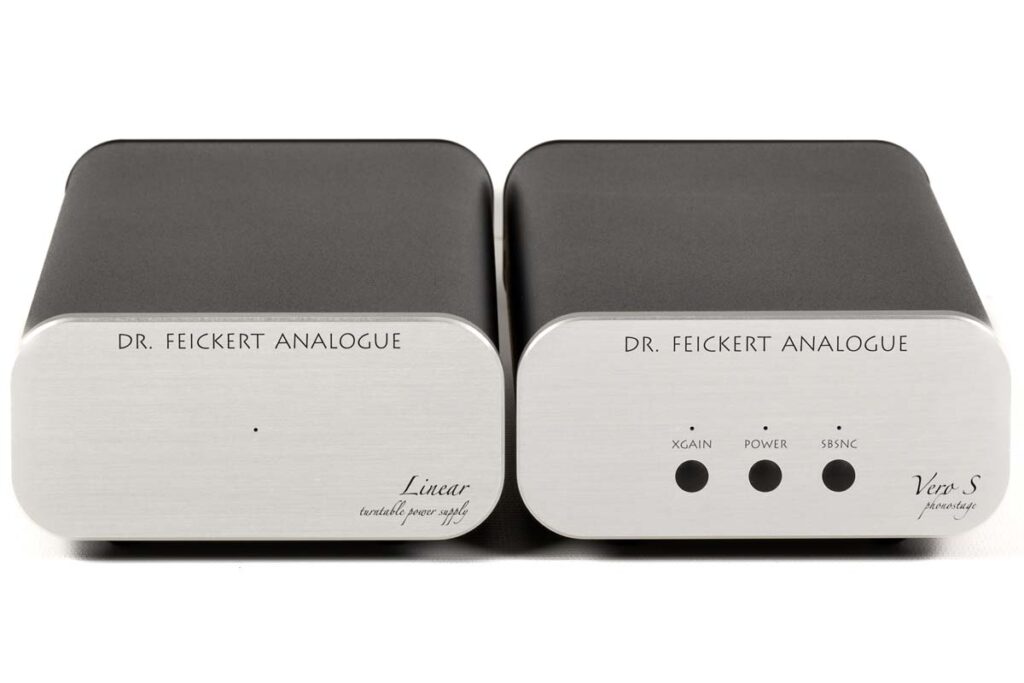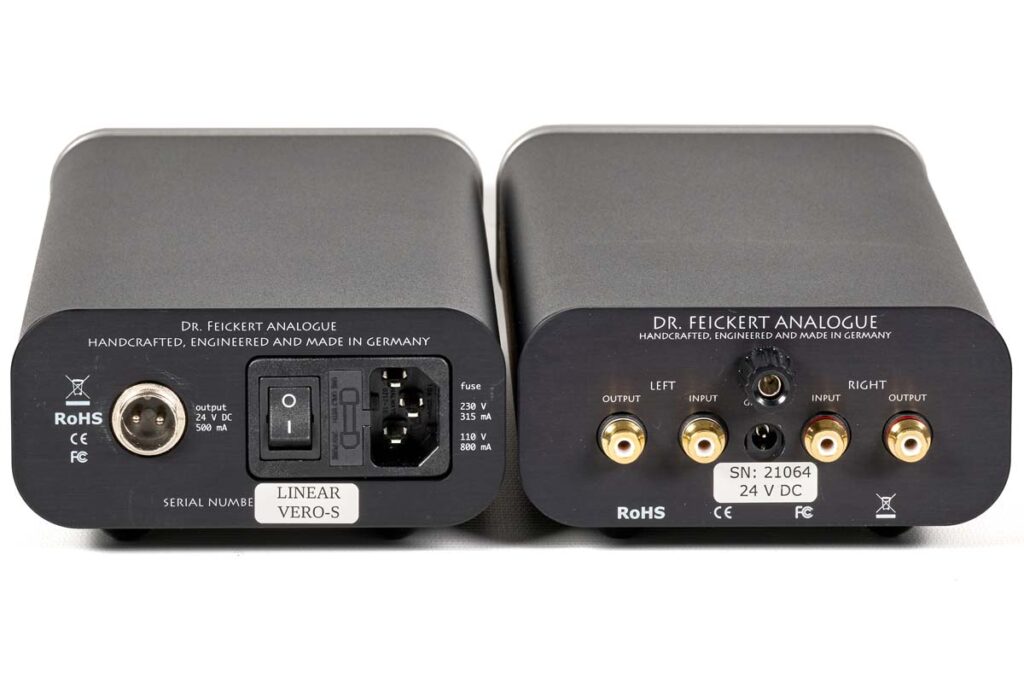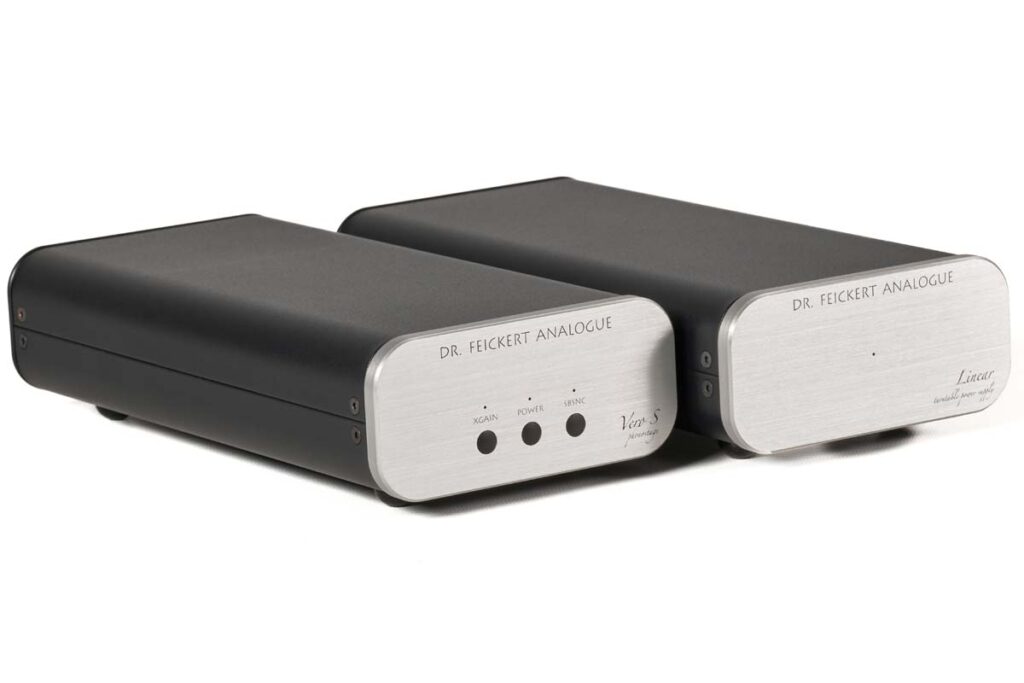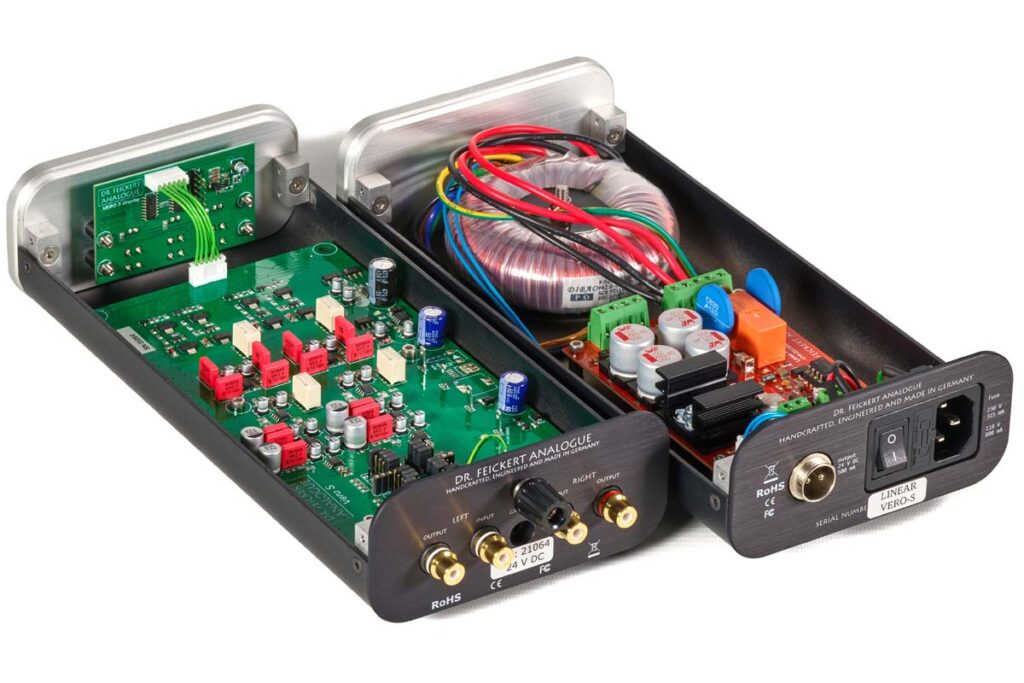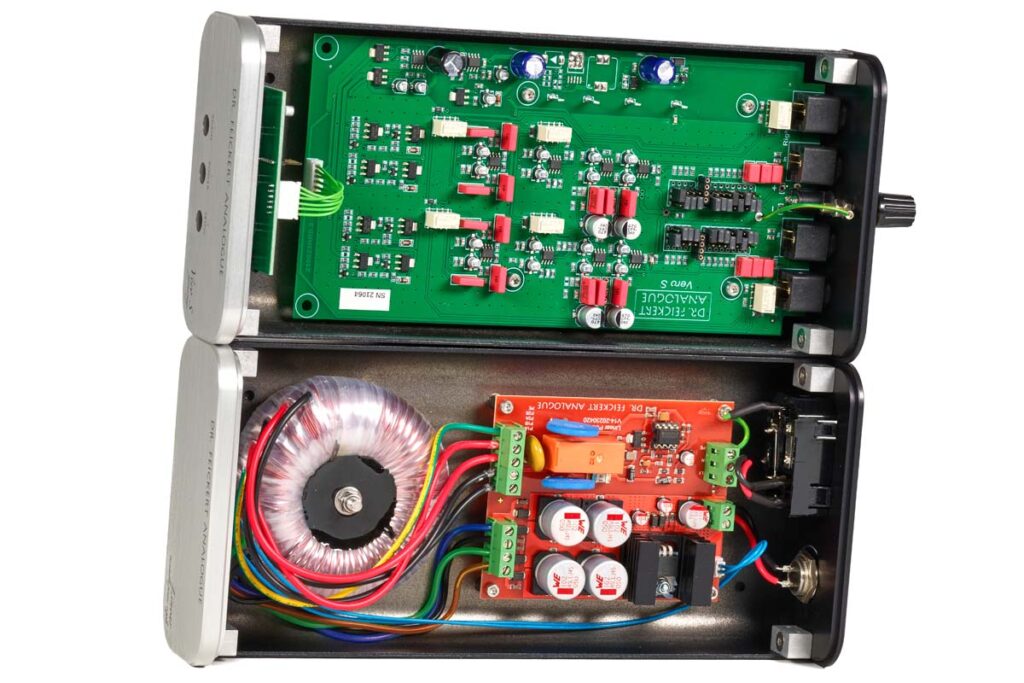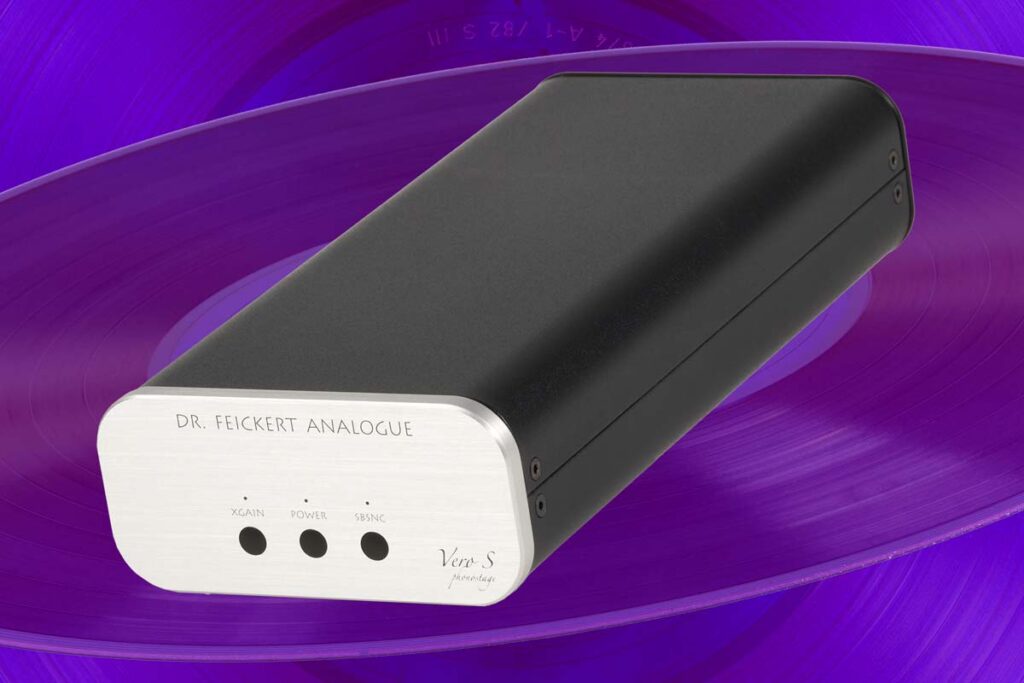Turn four into one or the consistent reduction to the essentials.
In a nutshell, this is the concept of the Dr. Feickert Vero S. Whereas the Vero was a full-blown preamp with two line and four phono inputs, the Vero S is limited to what is important in a normal hi-fi system: one input and one output. It is still even possible to adapt it to your individual MC system, but not by remote control. And the MM output is not independent, as in the larger Vero. Nevertheless, the S version is happy to accept signals from moving magnets. Makes sense!
The high-quality housing of the Vero S has taken its place in the rack. In this case, the external power supply is the “Linear” power supply specially adapted to this equalizer preamplifier. The standard version comes with a 24-volt plug-in power supply (so the device is always on standby). When the optional Linear power supply unit is switched on, the middle LED on the brushed aluminum front panel lights up softly, and pressing the button underneath switches the Vero S from standby to the actual operating mode. Connect the cable, up and running! Before I describe my first sound impressions, a few words about the other options, as there are a total of three push buttons on the front panel. To the left of the power button is the “XGain” button – here the output signal is amplified by an additional 12 decibels. The output voltage then increases from 500 millivolts to 2 volts (level of a normal line source). This may be useful in individual cases, but logically also increases the background noise, which I was unable to notice in normal operation (without XGain).
The “SBSNC” button on the right optionally switches on a subsonic filter. Specifically, this is a high-pass filter with a 12 decibel/octave slope that no longer allows the signal to pass below 20 Hertz and thus prevents low-frequency components from being passed on to the amplifier during the sampling process. Can you hear that? Well, it doesn’t change the musical presentation, as it only becomes effective below our hearing threshold. In any case, it relieves the subsequent amplifier circuit and, in my opinion, can be active at all times.
The rear of the device has two pairs of RCA sockets for input and output, an earth terminal and a socket for the power supply. The hard power switch and the IEC socket are part of the linear power supply, which with its 40 VA O-core transformer provides more substance and even more precise timing in the sound.
I can adapt the Feickert Vero S internally to my system using jumpers. A helpful and easy-to-understand table in the well-written operating instructions explains which jumper position I need to set for which amplification in decibels. The range extends from 38 decibels to 66 decibels in six stages. Jumpers can also be used to adjust the termination impedance in 28 stages (between 8 ohms and 1.8 kOhms for MC and 47 kOhms for MM systems) and the input capacitance for MM systems (between 100 pF and 790 pF). Together with the inductance of the MM system and the cables used, this results in a low-pass filter whose upper cut-off frequency decreases with increasing capacitance, so the standard setting of approx. 100 picofarads should generally be optimal. Nevertheless, if necessary, this adjustment can be used to minimize possible interference. RIAA equalization is partially active. The bass and mids are actively equalized, while the treble is passively equalized.
The housing itself is opened with a 2-millimeter Allen key. A look inside confirms the expectations of the Vero S. The work here is clean and precise. Each channel has its own amplifier circuit, implemented with ICs (Class A operation) in SMD design. The jumpers are easy to change with a little dexterity. And once the settings have been made for the system, you don’t have to touch them again.
After the first few relaxed records with the Feickert Analogue preamp, one or two characteristics emerge. The first thing you notice is the precise timing of the Vero S. Whether jazz, rock or pop, the transients are always clearly defined, direct and not polished. A bass drum on Roxy Music’s Flesh & Blood sounds grippy, with a slight treble component that gives the attack on the drumhead an exact time signature. Other preamps can do this in a similar way. What the Feickert equalizer does particularly well, however, is not to let the transient get lost in the subsequent tonal energy. Here you can clearly hear the difference in dynamics between the first impulse and the decay of the instrument. The bottom line is that this leaves room for the details of individual instruments and subtleties in the mix. This allows Bryan Ferry’s voice – with or without effects – to emerge solidly and freely in the stereo center and be framed by the instruments of his band. The period-produced “Rain, Rain, Rain” is a good example of this. Alan Spenner’s fretless bass sings the low-frequency lines with abandon, Neil Hubbard lets his guitar interjections flash at the edges of the stereo stage. And all the instruments have space and groove thanks to the fast rise time of the Feickert circuitry. One characteristic that I already know from Chris Feickert’s turntables is good timing, and he has also skillfully achieved this with the Vero S and (as far as I can remember from a past listening session) the large Vero preamplifier.
My Audio-Technica AT33-PTG/II runs through the reissue of Steely Dan’s Pretzel Logic. The former hit “Rikki Don’t Lose That Number” is passed through to the bobbing author with a groove-accentuated sound despite the somewhat denser compression of the reissue. It sounds different to Roxy Music, and that’s how it should be. Becker & Fagen’s tracks sound more earthy, the instruments more natural than on Ferry’s eighties masterpiece. Between the individual songs and in piano passages, it is as quiet as a mouse. The Feickert outperforms my already low-noise Luxman E-250, which is priced in the same region. The 62 decibel amplification with 370 Ohm terminating resistor set in the test device exactly matches the MC system I use. I change the terminating resistor to 47 kiloohms in order to feed the Vero S with signals from my MM system (Audio-Technica VMN50SH with Shibata stylus). I reduce the gain to 42 decibels. This is done separately for each channel using small but easy-to-handle jumpers inside the housing. All you have to do is loosen four Allen screws of the precisely manufactured housing and lift off the cover. Steely Dan’s timing is similar, but the MM system, which is a little “cozier” overall, warms up the sound a little in the lower mid-range compared to the MC cartridge. The scanning ability of the Shibata stylus brings out a similar amount of detail from the groove, and the high frequencies sound silky and open, just as I would expect from an MM. The differences between the system and the turntable are easy to hear, the test author’s favorite, so to speak! Even though the Vero S does not have its own MM amplifier branch compared to its big sister, it is still able to pass the music on to the system rhythmically, with good separation of the instruments and the right feel for moving magnets.
An interesting current production is the new album by the American band Lo Moon. On I Wish You Way More Than Luck, the individual frequency ranges are equally represented despite the dense mix by Alan Moulder (including Depeche Mode, U2 etc.). Via MM, it sounds full-bodied with pressure and still enough detail to separate the subtleties of the rhythm section, the percussive elements and the large-scale keyboards from the song-serving lines of the electric guitar. Matt Lowell’s vocals are more in the style of early Peter Gabriel than Mark Hollis (Talk Talk). “Borrowed Hills” is a track that brings out all these facets. And yes, that’s how I like the drum sound. I go back to the other drive with the MC system. This time I turn it down a little at 318 ohms. The record is the same. The stage opens up a little wider than with the MM system and the dynamic structure of the production moves a little more into my personal focus. The groove and the direct response remain the same. To the point and without softening the envelope of the instrument captured during recording, the Vero S extracts the musical essence from the record. I just let it run through.
With extremely variable adaptation to MM and MC systems and a fast, rhythmically and dynamically exact conversion of the supplied signals, the small phono preamp from Dr. Feickert Analogue convinces me. If you only have one turntable at home and rarely change systems, the Vero S could be the ideal solution, especially as it’s nice to know that this finely crafted and cleanly constructed equalizer preamp is made in Germany!
Accompanying Equipment
Phono preamplifier: Luxman E-250 | Headphone amplifier: Graham Slee Solo | Headphones: Shure SRH 1540, Austrian Audio Hi-X60 | Turntables: Elac Miracord 70, Rega Planar 3 | Cartridges: Audio-Technica AT33-PTG/II, Audio-Technica VMN50SH | Integrated amplifier: Luxman SQ-N150, Linn Majik | Speakers: Klipsch Heresy IV | Cables: Ecosse, Supra, Graham Slee, TaraLabs, Furutech
Phono preamplifier Dr. Feickert Analogue Vero S with power supply Linear
Concept: phono stage with RIAA equalization | Special features: 12 dB additional amplification possible, 28-stage impedance adjustment via jumper in the device, selectable input capacity (MM), subsonic filter, German operating instructions; optional power supply Linear (123/65/285 mm, 4 kg), in a bundle with Vero S for €749 | Inputs: 1 x unbalanced RCA | Outputs: 1 x unbalanced RCA | Finishes: Black, Silver | Dimensions (W/H/D): 123/65/285 mm | Weight: 1.75 kg | Price: around € 1490
SWS-audio GmbH
Stegenbachstraße 25b
79232 March
Phone +49 231 126748 or +49 172 5307700
swsnord@t-online.de

